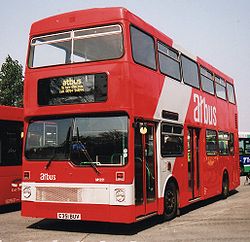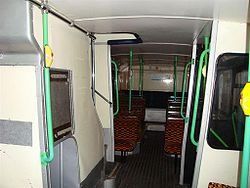- MCW Metrobus
-
MCW Metrobus
A typical MkI Metrobus. This example is owned by Atbus.
Arriva Buses Wales Metrobus Lower Saloon InteriorManufacturer Metro Cammell Weymann Operator(s) National Express West Midlands and others Specifications Length 9.7m, 11m or 12m Width 2.5m Floor type Step entrance Doors 1 to 3 door Engine(s) Gardner/Rolls Royce/Cummins/ Transmission Voith/Maxwell Options Various customer options The MCW Metrobus is a double decker bus model manufactured by MCW (Metro Cammell Weymann) from 1977 until 1989, with over 4,000 examples built. The original MkI model was superseded by the MkII model (which had a symmetrical windscreen) in 1981/1982, although production of the original MkI continued for London Transport until 1985. The Metrobus was conceived as an integral product manufactured completely by MCW, but Alexander and Northern Counties also bodied some examples.
The Metrobus was hoped to produce a single deck version but this was not to come into production. MCW mentioned the vehicle in the brochure but for some reason chose to focus only on the double deck version.
Contents
The UK
 National Express West Midlands MkII Metrobuses seen in Dudley. Metrobuses are no longer in service with NXWM.
National Express West Midlands MkII Metrobuses seen in Dudley. Metrobuses are no longer in service with NXWM.
In the United Kingdom, the Metrobus was mainly used in the metropolitan areas, especially London and the West Midlands.
The demonstrator TOJ 592S was lent to London Transport in December 1977. LT were so impressed with the vehicle they placed an order soon after. This prototype Metrobus is owned and still operated by Midland Classic of Swadlincote, Derbyshire.
London
London Transport took 1,440 MkI examples between 1978 and 1985, numbering them as M1 to M1440. Two MkII prototypes were delivered to London Transport as M1441 and M1442 in 1984, but there were no further orders. In 1987 and 1988, 14 secondhand Metrobuses were purchased from Greater Manchester PTE, West Yorkshire PTE and Busways. London Transport's low-cost subsidiary Harrow Buses leased 29 new MkII Metrobuses in 1987, but had to return them to their lessor three years later. London Transport's Metrobuses were the mainstay of the double decker fleet between 1987 and privatisation in 1994, when most of them passed to seven of the new operators. They remained in service for London Buses until 2004, when the last examples were withdrawn.
West Midlands
Main article: West Midlands MetrobusThe West Midlands PTE and its successor, West Midlands Travel (now National Express West Midlands), also took significant numbers of Metrobuses (over 1100), both MkI and MkII examples. These included 5 prototype vehicles (allocated to Washwood Heath depot near the MCW factory so they could see the vehicles performance in service) and 50 dual-purpose Metrobuses with high-back seats, purchased in 1986. Many of these buses were converted to normal seated buses and continued in service until November 2008. They were mainly used on limited-stop services. 14 guided buses were delivered for service 65 (branded Tracline 65), which was the first guided bus system in UK, although the experiment only lasted a couple of years.[1] All of the 14 guided buses were converted for conventional use and all have since been withdrawn.
The last public service ran the 1 service from Birmingham Town Hall to Acocks Green Village, arriving back at Acocks Green Garage at 15:25 on Saturday 24th July 2010 and was bus 2903 C903FON. A Metrobus Farewell event was held at Acocks Green on that day and all 3 of the last Metrobuses were operated, these were 2832, 2903 & 2988 (B832AOP, C903FON & E988VUK) All cash fares taken on the day were donated to Cancer Research UK.
South Yorkshire
South Yorkshire Passenger Transport Executive (SYPTE) purchased over 100 examples between 1981 and 1985. The SYPTE standard fully sprung seats were fitted along with 20 MkIIs having coach seats for express work. The vehicles were noted for quick acceleration although had distinctive engine noise and were rust prone around the engine bay.
The Metrobus also found sales in National Bus Company (UK) prior to privatisation, Maidstone and District and Northern bought significant numbers, later privatised NBC's bought second hand examples.
Secondhand Metrobuses have been purchased by operators both in the United Kingdom and the Republic of Ireland. Often, these are used mainly on school contract bus services. Several ex-London Metrobuses were recently seen in service with Top Line Travel of York Ltd.
Notable Metrobuses
Two notable Metrobuses are WMPTE's 6831 (SDA 831S) and Strathclyde Buses MB70 (G408 OGD) which were the first and last Metrobuses built (MCW went into receivership in 1989). However, these vehicles have now both been scrapped (MB70 being scrapped by First Group). The final UK ones for Merseybus, Strathclyde Buses and West Midlands Travel are considered to have been badly constructed and not suitable for preservation. This may have been due to them being dismantled and rebuilt by Optare after they bought the design to the Metrobus in order to create the DAF DB250-based Optare Spectra, and indeed one of the Merseybus ones 0819 (F819YLV) had to be rebuilt by MTL's engineering team when only four years old in 1993. 6831, however, was a prototype and had a different electrical system and layout, and was considered non-standard.
The earliest preserved Metrobus is WMPTE's 6832 (SDA 832S) which was the second prototype delivered, and the first to have a more standard set-up. Another noted Metrobus is West Midlands Travel 3107 (G107 FJW), which actually never entered service with West Midlands Travel, because of its late delivery, it was sold to Optare and also DAF without entering service, to assist in the development of what became the Optare Spectra.
Hong Kong
Early introductions
In Hong Kong, the China Motor Bus (CMB) introduced 12 Metrobuses (MC1-MC12) in 1978 for its luxury coach services (which covered the routes between Repulse Bay, Stanley and the Central District). Within a year, MCW produced an 11-metre 2-axle version of Metrobus. Only 40 were produced globally, and all of which (MB1-MB40) were acquired by CMB between 1978 and 1979. The MB class were allocated mostly on express and cross-harbour services. Both batches of CMB Metrobuses had MkI bodies.
1980s
In 1981, MCW provided prototypes of 3-axle, 12-metre long "Super-Metrobus" for both CMB and Kowloon Motor Bus (KMB). Two prototypes (ML1 and ML2) entered CMB services [ML2 was the only 3-door Metrobus in CMB's fleet] and KMB acquired three (M1-M3, later renumbered 3M1-3M3), all were bodied with MCW MkII body. In return, CMB purchased 82 more Super-Metrobuses (ML3-84) between 1983 and 1988, while KMB purchased 80 2-axle Metrobuses (M1-M80, with MkII bodies) between 1983 and 1985.
While KMB was not interested in the 12-metre version Super-Metrobuses, they did express their interest in an 11-metre 3-axle version (the CMB 11-metre version Metrobuses were 2-axle). 254 11-metre 3-axle Metrobuses (S3M1-254) were purchased by KMB between 1986 and 1989. 50 of these buses were fitted with Cummins engines, and another one (later numbered S3M145) was originally fitted with a Sütrak air-conditioner (as a prototype air-conditioned bus), but the air-conditioning unit proved unreliable and was subsequently removed.
Between 1987 and 1989, KCRC also purchased 59 2-axle Metrobuses for their feeder bus services. 39 of them (101-139) were brand new with MkII bodies, while another 20 (140-159) were second-hand buses bought from England (originally owned by South Yorkshire PTE) with MkI bodies.
Argos Bus purchased 6 Metrobuses for their non-franchised routes and private hire services between 1988 and 1989. They were from the same batch as those bought second-hand by KCRC.
KMB purchased 8 more 2-axle Metrobuses (M81-M88) in 1989. These buses were fitted with Cummins LTA10-B282 (282hp) engines and Voith D864G 4-speed gearbox, and were used on the hilly KMB Route 51 (between Tsuen Wan and Kam Tin, climbing Tai Mo Shan along its way). Later KMB converted some of the older Metrobuses with Cummins engine replacements, in order to avoid excess damage to buses running the hilly route.
It is rumoured that CMB was still asking MCW for more Super-Metrobuses when MCW ceased bus production in 1989. After CMB had learnt about the closure, it decided to buy 12-metre 3-axle buses from Dennis.
Withdrawal
 A Kowloon Motor Bus MCW Super Metrobus 12m MkII, withdrawn after use as a training bus, awaiting for scrap in a scrapyard.
A Kowloon Motor Bus MCW Super Metrobus 12m MkII, withdrawn after use as a training bus, awaiting for scrap in a scrapyard.
The MkI second-hand Metrobuses were the first to be withdrawn, and all of them have now been scrapped. Many of the KCRC ones were loaned to Citybus for few years before final withdrawal.
CMB removed its MC-class Metrobuses from the luxury routes after introducing Dennis Darts for the service in 1991, preserving the seating layout. These Metrobuses were allocated to non-luxury routes in the Southern District, Hong Kong, as well as route 13 serving the "Mid-levels". Although CMB was the first to introduce Metrobuses, it withdrew only 3 of them (all were accident victims) before the end of its franchise in August 1998. Its earliest Metrobuses were 20 years old at that time. New World First Bus (NWFB) purchased all the remaining CMB Metrobuses and Super-Metrobuses when it took over most of the CMB routes. These Metrobuses were then swiftly scrapped or (for most Super-Metrobuses) exported. As of 2007, there are still around 10 Super-Metrobuses from CMB providing tour service in Australia and the United Kingdom. The Super Metrobuses in Australia had their Gardner 6LXCT engines replaced by Cummins ISC units with Euro III or Euro IV emission standards.
The former CMB ML1 was bought by Andrew Haviland, a private collector, and restored at the Sydney Bus Museum in Sydney, Australia. The restored bus went into its first service as an Australia Day 2007 shuttle in Sydney.
KMB allocated its 3 Super-Metrobuses to the New Territories for many years. For example, they were serving on route 61A (which connected Tuen Mun and Yuen Long new towns) right before the KCR Light Rail took over the services. After that, they were seen on route 36A (which connected a public housing estate in Kwai Chung to a ferry pier) until the route's decline in the mid-1990s. They spent a few further years as spare buses before being withdrawn from passenger service in 1996 and converted to training buses. They were finally sold and scrapped in 2001.
KMB started to withdraw its 2-axle Metrobuses in 1997. Some of them had their chassis damaged due to the fatigue caused during their service on the Tai Mo Shan KMB Route 51, which climbed to the highest altitude achievable by buses in Hong Kong. KCRC also started to withdraw their Mark II Metrobuses in the early 2000s. The last 2-axle Metrobus in Hong Kong (KCRC 134) was withdrawn in October 2005.
The 11-metre 3-axle Metrobuses in KMB were not withdrawn until summer 2002. The last Metrobus in Hong Kong (KMB fleet number S3M233, license no. EH8559) ceased operation on 8 May 2007.
End of production
Production of Metrobus was terminated in 1989 with the financial collapse of MCW. The last Metrobus built was West Midlands Travel 3121, it had a message from the builders stating that it was the last one built by Metro-Cammell and signed by them on the inside of the roof.
The Metrobus design was purchased by Optare in 1990, which had recently joined the United Bus group with DAF Bus. Despite owning design and production rights, the two companies heavily reworked the design to produce a new vehicle, the DAF DB250-based Optare Spectra, which was launched in 1991 and ceased production in late 2005.
External links
References
Categories:- Buses
- Double-decker buses
Wikimedia Foundation. 2010.






